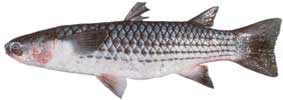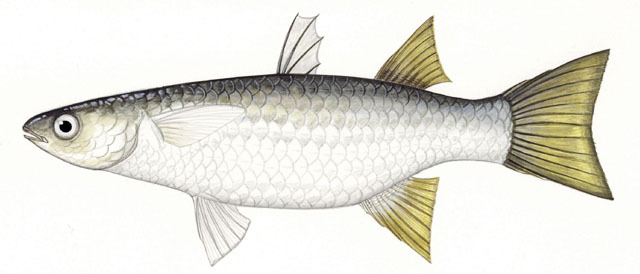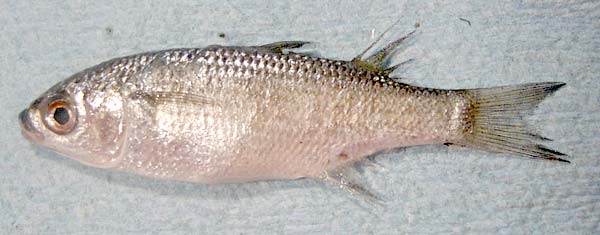
Liza grandisquamis
FAMILY
Mugilidae
TAXONOMY
Mugil grandisquamis Valenciennes, 1836, Gorйe, Senegal.
OTHER COMMON NAMES
French: Mulet йcailleux; Spanish: Liza escamuda.
PHYSICAL CHARACTERISTICS
Commonly reaches 9.8 in (25 cm) in standard length but may
reach up to 15.7 in (40 cm) in fork length. Teeth on both lips
are absent or are very small, well spaced, and positioned in a
single row on the upper lip, or rarely, in two rows. The anal
fin has three spines and nine soft rays in adults. There are
26–30 scales in a longitudinal series along the flanks. Body is
darkish dorsally and slightly paler and silvery laterally and ventrally.
The anal fin and lower lobe of the caudal fin may be
yellowish.
DISTRIBUTION
West Africa from Senegal to the Republic of Congo.
HABITAT
Usually found in brackish waters covering muddy substrates,
such as mangroves, creeks, estuaries, and inundated mudflats.
BEHAVIOR
Little is known.
FEEDING ECOLOGY AND DIET
Adults feed in schools, mostly at night, on particulate organic
matter, mud, diatoms, algae, microarthropods, foraminiferans,
and free-living nematodes. During the wet season fish take a
greater proportion of fine organic material than coarser sands,
because increased rainfall brings more fine allochthonous material
into rivers and “washes” the sand sediments free of fine
food material.
REPRODUCTIVE BIOLOGY
Populations from the Ebrie lagoon, Ivory Coast, do not show a
seasonal spawning cycle; spawning occurs principally in the lagoon
but also may occur in the sea.
CONSERVATION STATUS
Not threatened.
SIGNIFICANCE TO HUMANS
Small commercial and subsistence fisheries. A potentially important
species for aquaculture.
Other popular Animals
Photo Gallery of - Large-scale mullet





 Animalia Life
Animalia Life